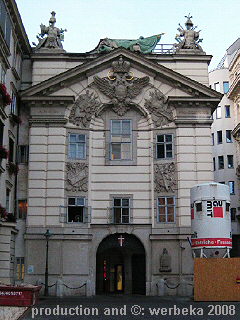
Am Hof (At the Court)
The name "Am Hof" goes back to the court of the Babenbergs (reigning in Austria before the Habsburg family), the residency of Duke Heinrich II Jasomirgott. He placed his court here, when he in the 12th century chose Vienna as his capital. He built the court on the spot, where 2000 years earlier the Roman military camp Vindobona had been situated. Here he gave a glittering party, which lasted two weeks, for Emperor Friedrich Barbarossa, when the latter passed Vienna on his crusade. Also the famous minstrels Reinmar von Hagenau and Walther von der Vogelweide were guests here. Later, when the Habsburgs had moved to the castle of today, the square Am Hof became a marketplace.
 |
At the end of the 14th century the Order of the Carmelites was given the right to settle here by Albert III. They built the convents church here, which was finished soon after the year 1400. In 1554 the church and the abbey were given to the Jesuit order, which had its homestead there until 1773. Afterwards the War Council of the Court had its seat here until 1913.
In the year 1806 it was from this church that Emperor Franz II delared the Holy Roman Empire of German Nation for abandoned and made himself Emperor Franz I of Austria. |
But the square "Am Hof" was also used as a place for execution. In 1463 a mayor of the city was hanged here and in 1595 a very prominent person was sentenced - Ferdinand Graf zu Hardegg - because he had left the fortress of Raab to the Turks without fighting. And as one was busy with sentencing, one also cut of the head of the builder of named fortress ...
 |
At number 10 we find the civilian armory, which was in use already in the 16th century. Here were the weapons, which in case of emergency would be handed to the inhabitants, in order to help defending the city.
In 1732 the main front of the house was redesigned by Anton Ospel. In 1809 the army of Napoleon depredated that armory.
In March 1848 the people stormed the armory during the revolution and in October of the same year they pulled out the Minister of War, Theodor Graf Baillet von Latour, from this building. The raving pack beat him to death and hanged him afterwards on a lantern in the middle of the place.
In the cellar of the house one can find the excavations of a part of the Roman military camp. Today the former armory is given to the fire brigade, which also owns the neighbouring house, number 9. There the fire brigade was founded in 1686, thus being one of the oldest in the world. |
The fire brigade has further a garage at the square, in the house number 7. That was originally designed by the famous Lukas von Hildebrandt in 1730, but was changed later. There is a fire brigade mueum, which though only is open on Saturdays and Sundays - and then only between 9 and 12.
Between those two houses last mentioned, there is the narrow, red house in Renaissance style, the backside of which also can be admired from the street "Tiefer Graben".
In the center of the square is a statue of the Madonna, which had been raised by Emperor Ferdinand III in 1646, thankful that the Swedish troups didn't attack Vienna in the Thirty Years War, and instead went northward again. The original statue was made of marble and was created by Johann Jakob Pock. Twenty years later it was transported to the castle of Wernstein and a copy in bronze was put here.
In former days there was another statue standing on this square.
|
 |
 |
That was an equestrian statue of Fieldmarshall Radetzky, which was erected in 1892. But also this statue was moved twenty years later. Today it can be found on the Ring.
Even if there have happened many horrible things on the square Am Hof, there ware also happier events to enjoy. From mid 19th century - and with some interruptions until today - there was a Christmas-market held, with all that is part of it. Also the big jumble sale, which has been displaced to the Naschmarkt because of shortage of space, had its origins here.
But let us continue with the buildings around the square. At number 12 we find the so called Urbanihaus, the construction of which already started in 1630, and even then it was raised on older groundwork. Since early 20th century the Urbanicellar (a wine restaurant) has its home here. |
 |
The house next to it is the Palais Collalto. It was built about 1670 and got 50 years later a new facade. A sign on the house tells, that is was here, that Mozart had his public debut in Vienna, in October 1762. Even later he is said to have been a frequent guest.
The houses number 2 to 6 all were built in the 19th or 20th century.
At number 2, today owned by the Bank Austria, there is a sign in remembrance of Henri Dunant, the founder of the Red Cross. The sentence on it says: "In the Battle of Solferino the conscience of the world remembered its responsibility of mercy." The brutality of the battle between Sardinia-Piemont and France on one side and Austria on the other, gave Dunant the idea of a medic troup, which was granted the the Convention of Geneva in 1864.
|
© Bernhard Kauntz, Västerås 2013
Back to  or to the or to the  of of 
30.9.2013 by webmaster@werbeka.com
|







